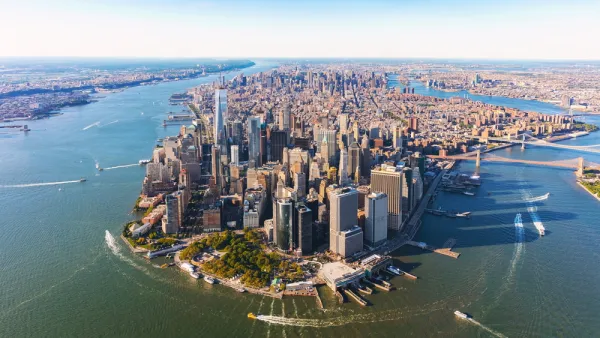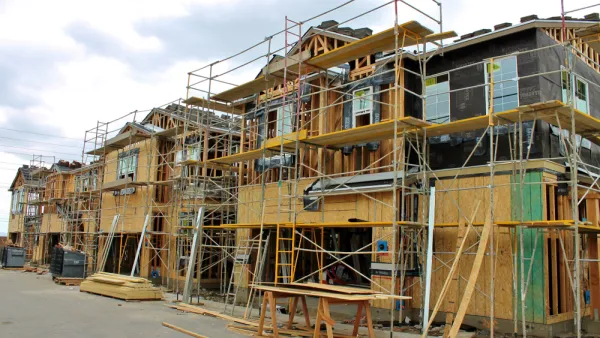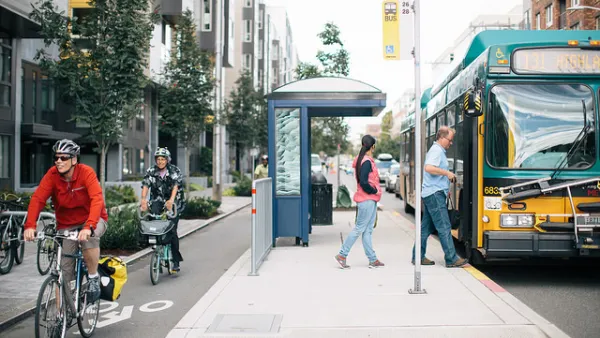As cities build upwards in an effort to create more housing and increase walkability, research shows that tall buildings intensify heat and contribute to increased carbon emissions.

"A report by the United Nations’ Intergovernmental Panel on Climate Change released on Monday looked at the relationship between housing, building structures, and broiling city blocks and found that deaths from heatwaves — like the one in Chicago [in 1995] — are not a coincidence," reports Adam Mahoney. The "report found that the single biggest contributor to amplifying heat and warming in cities is 'urban geometry,' the relationship between city layouts, building construction, and density," and that "[t]he main problem driving the so-called 'heat-island effect' is tall buildings." Because of this, "[u]rban centers can range as much as 22 degrees warmer than nearby rural areas."
[C]ities and states across the country — in Ohio, New York City, and back in Chicago, developers are building taller affordable housing, going up, not out, in an effort to create density, walkable neighborhoods where infrastructure costs are lower and jobs, stores, and homes are closer together. The trick is finding a solution that offers everyone safe and quality housing without overheating the planet.
John Mandyck, CEO of the Urban Green Council in New York City, says "[c]ities could create gardens in the sky, which have successfully offered natural cooling and improved air quality in cities like Chicago, as well as planting trees and bushes to shade sidewalks and streets." Other solutions include reflective roofing systems, which in New York City alone prevent "an estimated 2,500 tons of CO2 emissions every year."
While building up may mitigate the housing crisis, "it’s not even one percent of the solution to our environmental problems because it adds challenges even as it mitigates some," says Rick Cole, executive director of the Congress for New Urbanism. "More than 25 years after that first Cabrini tower came down, U.S. cities are much more equipped to tackle housing problems and the climate crisis, but action requires political willpower and individual sacrifices."
FULL STORY: Tall buildings: Good for the housing crisis, bad for the climate crisis

National Parks Layoffs Will Cause Communities to Lose Billions
Thousands of essential park workers were laid off this week, just before the busy spring break season.

Retro-silient?: America’s First “Eco-burb,” The Woodlands Turns 50
A master-planned community north of Houston offers lessons on green infrastructure and resilient design, but falls short of its founder’s lofty affordability and walkability goals.

Delivering for America Plan Will Downgrade Mail Service in at Least 49.5 Percent of Zip Codes
Republican and Democrat lawmakers criticize the plan for its disproportionate negative impact on rural communities.

Test News Post 1
This is a summary

Test News Headline 46
Test for the image on the front page.

Balancing Bombs and Butterflies: How the National Guard Protects a Rare Species
The National Guard at Fort Indiantown Gap uses GIS technology and land management strategies to balance military training with conservation efforts, ensuring the survival of the rare eastern regal fritillary butterfly.
Urban Design for Planners 1: Software Tools
This six-course series explores essential urban design concepts using open source software and equips planners with the tools they need to participate fully in the urban design process.
Planning for Universal Design
Learn the tools for implementing Universal Design in planning regulations.
EMC Planning Group, Inc.
Planetizen
Planetizen
Mpact (formerly Rail~Volution)
Great Falls Development Authority, Inc.
HUDs Office of Policy Development and Research
NYU Wagner Graduate School of Public Service





























